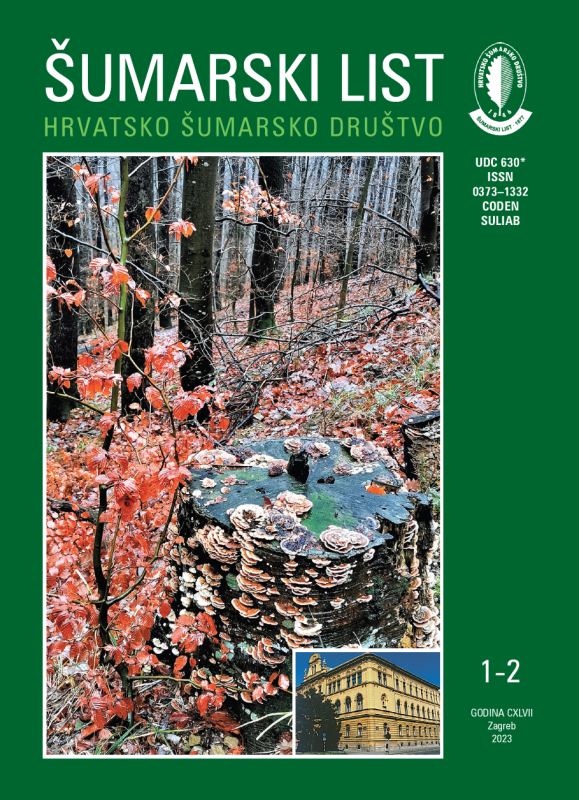
broj: 1-2/2023
pdf (8,7 MB) |
|
||||||||||||||
| RIJEČ UREDNIŠTVA | ||
| Uredništvo | ||
| How is the leased forestland used? pdf HR EN | 5 | |
| IZVORNI ZNANSTVENI ČLANCI | ||
| Ida Katičić Bogdan, Višnja Jurkić, Ivana Brlek, Marko Bačurin, Saša Bogdan | UDK 630* 165.+181.8 (001) https://doi.org/10.31298/sl.147.1-2.1 | |
| Genetic diversity of reproductive and phenological traits and their interrelationships in a clonal seed orchard of Wild Cherry (Prunus avium L.) pdf HR EN | 7 | |
| Krunoslav Teslak, Marijana Andabaka, Andrea Mertini, Karlo Beljan, Mislav Vedriš | UDK 630* 622+631 (001) https://doi.org/10.31298/sl.147.1-2.2 | |
| Choice of adaptive forest management model based on long-term projection in dinaric fir-beech stands pdf HR EN | 21 | |
| Milica Marčeta, Ljiljana Keča, Stjepan Posavec, Sreten Jelić | UDK 630*901 (001) https://doi.org./10.31298/sl.147.1-2.3 | |
| Socio-economic characteristics of forestry companies in the Republic of Serbia pdf HR EN | 39 | |
| Mirzeta Memišević Hodžić, Dalibor Ballian | UDK 630* 164 (001) https://doi.org/10.31298/sl.147.1-2.4 | |
| Variability of leaf morphological traits of european black poplar and hybrid black poplars in the clone archive in Žepče pdf HR EN | 53 | |
| Summary Black poplar (Populus nigra L.) is one of the most important European tree species, inhabiting alluvial habitats along the banks of large rivers. Today, it is one of the most endangered species of forest trees due to habitat devastation, regulation of river flows, excessive exploitation, and the introduction of non-native tree species with which it hybridized. This study aims to determine the variability of morphological properties of black poplar leaves n Bosnia and Herzegovina, within and among populations, and among river basins. Material from the clonal archive of black poplars was researched. The archive was founded in 2005 in Žepče. It contains clones from 161 trees of indigenous black poplars from 26 populations throughout Bosnia and Herzegovina (from the basins of 6 rivers) and 15 hybrid poplar species (table 1 and table 2). Ten leaves were collected from each clone by taking the fifth leaf from the top of the main shoot. Five leaves from each clone were measured. The measurement was performed with a digital movable scale with an accuracy of 0.1 mm and a protractor. The following traits were measured: leaf blade length, leaf blade width, petiole length, total leaf length, the angle between the first lateral nerve and central nerve, and distance from the leaf base to the widest part of the leaf. The number of teeth on one cm above the widest part of the leaf was counted. Data were processed using SPSS 26.0 and EXCEL by populations and river basins. Analysis of variance revealed that there are statistically significant differences among the studied populations (table 4), as well as among river basins (table 7), for all investigated traits. The petiole length trait showed the highest variability, and the lowest variability had the insertion angle of the first lateral and central nerve (table 3). The clones of population of hairy black poplars Čapljina had the lowest values of leaf traits and differed significantly in all measured properties from the others. The most common number of teeth per 1 cm of leaf edge for all populations was four teeth (figure 2), which appeared on 38.3% of leaves. This research gives us a small insight into the morphological characteristics of black poplars in the clone archive Žepče and can be the basis for further researches of the traits of black poplars needed for a successful continuation of work on breeding this species. Key words: european black poplar; clone archive; morphological traits of laeves | ||
| Mehmet Kalkan, Mustafa Yilmaz, Rasim Alper Oral | UDK 630* 164 (001) https://doi.org/10.31298/sl.147.1-2.5 | |
| The morphological and chemical variability of Turkish Hazel (Corylus colurna L.) fruits in Turkey pdf HR EN | 65 | |
| PREGLEDNI ČLANCI | ||
| Hubert Codrow, Anna Wierzbicka, Maciej Skorupski | UDK 630* 156 https://doi.org/10.31298/sl.147.1-2.6 | |
| Factors shaping teenagers and young adults’ approach to hunting : a review of the literature pdf HR EN | 75 | |


